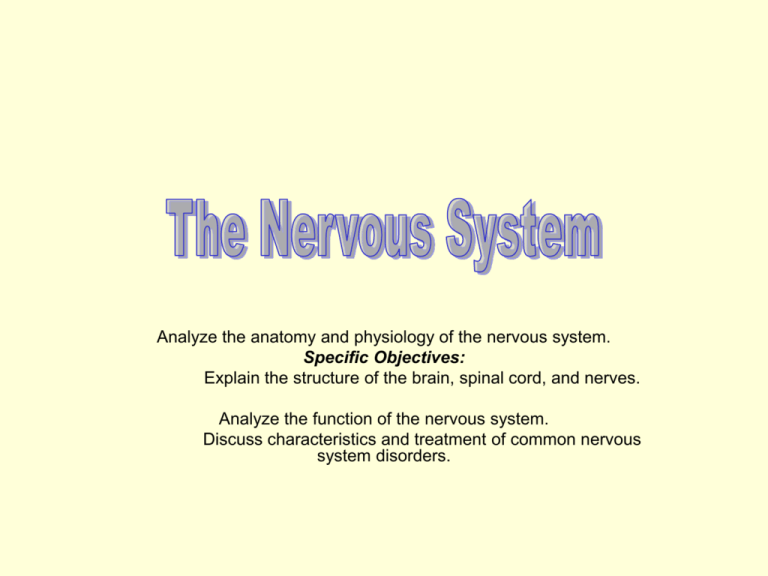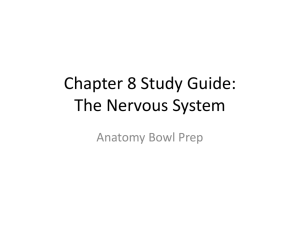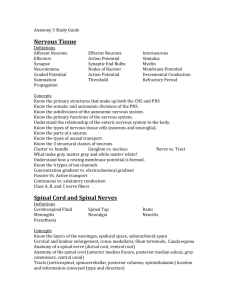Neurological Systemppt
advertisement

Analyze the anatomy and physiology of the nervous system. Specific Objectives: Explain the structure of the brain, spinal cord, and nerves. Analyze the function of the nervous system. Discuss characteristics and treatment of common nervous system disorders. Complete “My definition” column of use your brain • Page 7 in you pkt! Bell • Describe the function of the nervous system Function • Central nervous system • Communication and coordination system of the body • Seat of intellect and reasoning • Communication and coordination system of the body • Seat of intellect and reasoning • Consists of the brain, spinal cord, and nerves • Nerve cell • Transmits a message from one cell to the next • Has a nucleus, cytoplasm, and cell membrane • .Nucleus- “brain’ for control of cell’s metabolic activities and cell division • .Mitochondrion-site of cellular respiration, and energy production, stores ATP. Nerve Cell (Neuron) • DENDRITES • Nerve cell processes that carry impulse to cell body • May be one or many • AXON • Carries impulse away from cell body • Only one on a neuron Bell • Label B in packet • Myelin Sheath /Neurilemma Covering that speeds up the nerve impulse along the axon • Myelin is a fatty substance that protects the axon • Schwann cells white fatty substance that wraps itself around some axons. • Nodes of Ranvier indentions between Schwann cells • Neuroglia-Supporting cells that hold the neuron together. “Glia“is Greek for glue. Bell • Describe the function of a: – Dendrite – Axon – Neuron – What are the 2 main divisions of the nervous system? Message/Impulse • SYNAPSE –area where messages go from one cell to the next • Synaptic cleft space between neurons • Nerve impulse – A STIMULUS creates an IMPULSE. The impulse travels into the neuron on the dendrite(s) and out on the axon. At the end of the axon, a NEUROTRANSMITTER is released that carries the impulse across the SYNAPSE, to the next dendrite. • 100 billion neurons in the brain Different Types of Neurons • SENSORY NEURONS (AFFERENT) – emerge from the skin or sense organs, carry impulses to spinal cord and brain • MOTOR NEURONS (EFFERENT) – carry messages from brain and spinal cord to muscles and glands • ASSOCIATIVE NEURONS (INTERNEURONS) – carry impulses from sensory neurons to motor neurons Membrane Excitability text page 149 • A neuron membrane is…. • 1) At rest: large amt of potassium K+ ions inside and with few Sodium ( Na+) with them. Is a negative charge. • …here comes a sensory neuron receptor STIMULATED example sound! • 2) Na+ rushes in = action potential, creating depolarization and a positive charge. • 3) Next the gates open again and the K+ rushes back in = repolarization • This is repeated throughout the membrane over the entire nerve. • 1) Irritability- ability to react when stimulated • 2) Conductivity- ability to transmit a stimulus to another point. Sensory Pathway of CNS • CENTRAL NERVOUS SYSTEM – brain and spinal cord • PERIPHERAL NERVOUS SYSTEM – cranial nerves and spinal nerves – AUTONOMIC NERVOUS SYSTEM – includes peripheral nerves and ganglia, supplies heart muscle, smooth muscle and secretory glands, involuntary action Testing for Reflexes • • • • • • • • • • • • • Working in teams of two, have students take turns to carry out each activity. 1. Clap hands loudly about two feet in front of your partner’s eye. What reaction occurred? ___________________________________________ 2. Have your partner sit on a stool or on top of a desk. Using the side of your hand or a reflex hammer, tap the leg just below the knee. What reaction occurred? 3. Look at your partner pupils with the light on. Describe their size and shape. Turn the light in the room off. What happened to the pupils? 4. Have your partner stand in a doorway and ask him/her to press back of hands against the side of the door as hard as possible for 30 seconds. Step away and release arms. What happened to the arms? ________________________________________ Discuss which division of the nervous system is involved in reflex reactions. • 3 lb mass of soft nervous tissue • 100 billion neurons • Protected by skull, three membranes called meninges, and cerebrospinal fluid • Adequate blood supply is needed, brain tissue will die in 4-8 mins without O2 • Divided into 4 major parts: cerebrum, diencephalon, cerebellum, brain stem • List the layers of the MENINGES) Coverings of the Brain (MENINGES) • DURA MATER – outer brain covering, lines the inside of the skull, tough dense fibrous connective tissue. • SUBDURAL SPACE – between dura and arachnoid • ARACHNOID – middle layer, resembles fine cobweb, • PIA MATER – covers the brain’s surface, comprised of blood vessels held together by connective tissue • SUBARACHNOID SPACE - between arachnoid and pia mater,filled with CEREBROSPINAL FLUID – acts as a liquid shock absorber and source of nutrients for the brain. bell • Fill in the real definition….on Use your Brain grid for • Meninges • Dura mater • Arachnoid • Pia mater CEREBROSPINAL FLUID page 155 • Forms inside ventricles of the brain • Serves as a liquid shock absorber protecting the brain and spinal cord • BLOOD-BRAIN BARRIER – choroid plexus capillaries prevent substances (like drugs) from penetrating brain tissue – this makes infections, like meningitis, difficult to cure • LUMBAR PUNCTURE – removal of CSF from spinal canal, needle puncture between 3rd and 4th lumbar vertebrae Ventricles of the Brain See page 143 • • • • • Brain contains four cavities filled with cerebrospinal fluid called CEREBRAL VENTRICLES….4 cavities Right and left lateral ventricles Third ventricle – behind and below the lateral ventricles Fourth ventricle is below the 3rd, in front of the cerebellum and behind the pons and medulla oblongata CHOROID PLEXUS – network of blood vessels lining the ventricles which helps in the formation of cerebrospinal fluid • • Largest part of the brain Divided into R and L hemispheres-Left control right side of body and Right controls left side of body….by deep groove (longitudinal fissure) • CONVOLUTIONS – elevated folds on the surface of the cerebrum, they increase the surface area of the brain SULCI – fissure or grooves separating cerebral convolutions Divided into four lobes – FRONTAL, PARIETAL, OCCIPITAL and TEMPORAL •Parietal Frontal •Temporal •Occipital • • Cerebral function: Conscious thought, judgment, memory, reasoning, and will power. Bell • Define/describe (does not matter which column) on Use your brain: – 1st eight terms Location and Function Cerebral Lobes, Brainstem, & Cerebellum Memory/tidbit • The storage site for memory depends on the type of memory being stored. For example-runningmotor area • What you see while running-visual area Assignment/bell… • • • • Textbook pages 168 Answer 1-4,6,7 and 8 Complete Matching Make sure all cerebrum/lobe functions did you draw in cerebellum and stem? are labeled for The Brain Bell… • One each sticky note: Name the 4 lobes of cerebrum • List @ least 2 things things/functions that occur there CEREBELLUM • Located behind the pons and below the cerebrum • Composed of two hemispheres • Controls all body functions related to skeletal muscles, including: • Balance • Muscle tone • Coordination of muscle movements Bell • List each lobe of the cerebrum plus the cerebellum and all of the functions Diencephalon=Located between cerebrum and midbrain Composed of THALAMUS and HYPOTHALAMUS (pix 147) THALAMUS: acts as a relay station for incoming and outgoing nerve impulses Vital functions of the HYPOTHALAMUS: Autonomic nervous control Temperature control Appetite control Emotional state Sleep control (+BP, heartbeat, H2O balance, Oxytocin. GI. Mind over body) Workbook • Workbook Page 102-103 O • Complete the brainy Puzzler (crossword) • Made up of PONS, MEDULLA and MIDBRAIN • Pathway for ascending and descending tracts CONCIOUSNESS • Pons – in front of cerebellum, between midbrain and medulla – contains center that controls respiration • Midbrain – vision and hearing • Medulla oblongata – bulbshaped structure between pons and spinal cord, inside the cranium above foramen magnum. Responsible for: • Heart rate Video clip • http://www.youtube.com/watch?v=UfC4u5 GCy3I bell • • Complete Workbook Page 102-N On 5 strips of paper write Hypothalamus, Write function(s) of each 1) 2) 3) 4) 5) Midbrain Thalamus Medulla Pons Hypothalamus Label – Label as follows…. 1)Frontal 2)Occipital 3)Temporal 4)Parietal 5)Cerebellum 6)Brain stem Bell • • Matching page 156 text Create 10 long strips of paper – Label as follows…. 1) 2) 3) 4) 5) 6) 7) 8) 9) 10) Frontal Occipital Hypothalamus Temporal Parietal Cerebellum Thalamus Medulla Pons midbrain assignment….. • Answer 9 and 10 mult choice on page 168 in text • Workbook page, 102 N and O • Label midsagital diagram of brain( circled terms only) • Strip-activity • Complete real definitions- Use your Brain Bell • • • • • • Study functions and structures of…. Diencephalon Thalamus Hypothalamus Pons Medulla oblongata Bell • 1) What are the 2 divisions of the Diencephalon? • 2) What is the job of the thalamus? • 3) List at least 4 of the functions of the hypothalamus? • 4) Workbook page, 102 N and O • Begins at foramen magnum and continues down to 2nd lumbar vertebrae • White and soft, in spinal canal • Surrounded by cerebrospinal fluid • Functions as: • Reflex center • Conduction pathway to and from the brain • Pg. 166 Peripheral Nervous System All of the nerves of the body and ganglia Autonomic nervous system is specialized part of PNS • Bundle of nerve fibers enclosed by connective tissue • Sensory(A) nerves carry impulses to brain and spinal cord • Motor nerves(E) carry impulses to muscles or glands • Mixed nerves(I) contain both sensory and motor fibers • Spinal nerves • Originate at spinal cord and go through openings in vertebrae • 31 pairs of spinal nerves • All are mixed nerves • Named in relation to their location on the spinal cord • AUTONOMIC NERVOUS SYSTEM • Regulates activities of visceral organs • Not subject to conscious control • SYMPATHETIC NERVOUS SYSTEM – the “fight or flight” system – when the body perceives danger, SNS sends message to adrenal medulla to secrete adrenaline – heartbeat increases • PARASYMPATHETIC NERVOUS SYSTEM – counters effects of SNS, decreases heart rate Close up…. • • • • • • • • • • • • Olfactory Optic Oculomotor Trochlear Trigeminal Abducens Facial Vestibulocochlear Glossopharyngeal Vagus Accessory Hypoglossal • • Page 174 Workbook 109 B • • • 12 pairs that originate in different areas of the brain They are designated by number and name. The name may give you a clue as to its function Can't remember the names of the cranial nerves? • Here is a handy dandy mnemonic for you: • On Old Olympus Towering Top A FamousVocal German Viewed Some Hops. • The bold letters stand for: olfactory, optic,oculomotor,trochlear,trigeminal, abducens, facial,vestibulocochlear,glossopharyngeal, vagus, spinalaccessory, hypoglossal. • Reflex • Unconscious and involuntary • Like one way streets, impulse conduction only in one direction • In a simple reflex, only a sensory nerve and motor nerve involved – example, “knee-jerk” reflex, blink of an eye when dust touches , smell something good and you start to salivate. • Bell… • Text 156 • Theory to practice #2. NC Health Careers Book PICK 2 that Interest YOU! • • • • • • • • • • • • • Social Worker Pharmacist Pharm Tech Occupational Therapist OT Assistant Speech Language Pathologist Speech Assistant Electroneurodiagnostic Technologist EMT Physical Therapist Physical Therapist Assistant Recreational Therapist Rehabilitation Counselor • • • • • • Rubric (20 points each) Job Description Academic Requirements Work Environment Salary Range At least 2 educational programs Test Date • Thursday!...04/14 Bell… • Workbook: • page 99F • page 110, C …number paper 1-8 Bell…. • First fill in the blanks on outline so you can…… • Complete the grid for Neurological (see packet) disorders, may use text and notes • outline Disorders of the Nervous System • • • • MENINGITIS EPILEPSY Cerebral Vascular Accident ALZHEIMER’S DISEASE MENINGITIS Inflammation of the lining of the brain and spinal cord May be bacterial or viral Symptoms – headache, fever and stiff neck In severe form, may lead to paralysis, coma and death • If bacterial, may be treated with antibiotics EPILEPSY • Seizure disorder of the brain, characterized by recurring and excessive discharge from neurons Seizures believed to be result of spontaneous, uncontrolled electrical activity of neurons Cause – uncertain Victim may have hallucinations and seizures Grand mal – severe, convulsive seizure Petit mal – milder ALZHEIMER’S DISEASE Progressive disease that begins with problems remembering Nerve endings in cortex of brain degenerate and block signals that pass between nerve cells Abnormal fibers build up creating tangles Cause – unknown First stage (2-4 years) involves confusion, short-term memory loss, anxiety, poor judgment 2nd stage (2-10 years) increase in memory loss, difficulty recognizing people, motor problems, logic problems, and loss of social skills 3rd stage (1-3 years) inability to recognize oneself, weight loss, seizures, mood swings and aphasia Cerebral Vascular Accident • • • • Stroke or CVA Interruption of blood and O2 to brain Tissue death Third leading cause of death in USA • Requires a large team of rehabilitation specialists CVA Slurred Speech HTN CVA Athersclerosis Hemiplegia • Journal Highlights: Silent Stroke See also the following articles related to silent stroke recently published in Stroke AHA journals: • Prevalence and Correlates of Silent Cerebral Infarcts in the Framingham Offspring Study, Seshadri et al. • Brain Microbleeds and Global Cognitive Function in Adults without Neurological Disorder, Yaksuhiji et al. • World Stroke Day Wednesday, October 29, 2008 • The Joint World Stroke Congress — an organization composed of health organizations from around the world including the American Heart Association and the American Stroke Association — has declared every October 29th to be World Stroke Day. • On that day every year, the World Stroke Congress comes together on a unified message intended to educate the world public about the treatment and prevention of stroke. • In 2008, World Stroke Day will focus on silent stroke, which occurs 5 times as often as other strokes, without the usual warning signs or symptoms. This year’s World Stroke Day theme is “Little strokes, big trouble.” Risk Factors for CVA § § § § Smoking Hypertension Heart disease Family history • Causes of CVA • 90% caused by blood clots • • Clots lodge in carotid arteries, blocking the flow of blood to the brain • • 10% caused by ruptured blood vessels in the brain Symptoms § § § § § § § § Hemiplegia on opposite side of the body Sudden, severe headache Dizziness Sudden loss of vision in one eye Aphasia Dysphasia Coma Possible death Treatment • 1. Get to the hospital immediately!! • 2. CT done to determine etiology • 3. If a clot, treatment aimed at dissolving clot Prevention • If TIAs – one aspirin a day • Stop smoking • • Exercise and lose weight • • Control hypertension • Cerebral Palsy • Causes muscles to function incorrectly although they have normal intelligence. May be caused by hypoxia at birth Bell….. • From workbook, answer Q 1-10 page 103. Agenda for today • • • • • Use PP handouts to fill in disease grid Watch movie study for test Nap …not in that order Bell • Complete Q and R page 103 in workbook.








